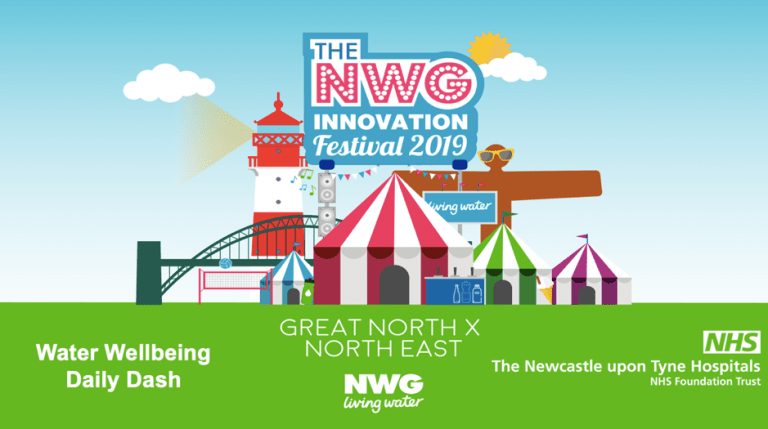Posted in Blog, Create, Lead by Jo North
CREATIVE FACILITATION. HOW TO DESIGN AN INNOVATION SPRINT FOR DIVERSE AND MULTIPLE STAKEHOLDERS
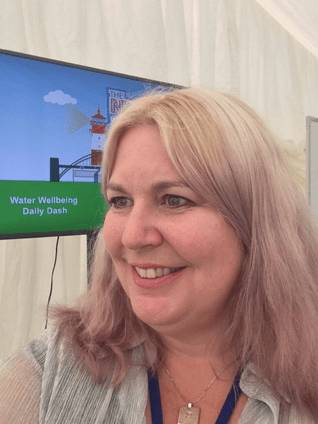
This month I designed and facilitated, with the support of RAF volunteers and pro facilitators Morgan and Sonic, an ‘innovation daily dash’ at Northumbrian Water’s Innovation Festival 2019, at the awesome Newcastle Racecourse venue.
Lots of people ask me about my workshop design process, so in this article I thought I would take you behind the scenes to show you step-by-step how I put together the agenda for a co-creation event.
My focus is on the design, techniques and process of the day. I will be writing another article about the outputs in a future article.
If you’d like to learn more about creative facilitation, get a free copy of my DIY Away Day toolkit here, a great resource for facilitators.
Yes please, I’d like my free DIY Away Day Toolkit!
And just a quick note before we get into the detail. As you will see from the photos, our innovation dash was in a marquee, which worked brilliantly and really contributed to the festival theme. We had other dashes going on in the same huge marquee, which is why in some photos we are wearing headphones and talking into a throwable microphone ball. These mike balls are great and lots of fun, as well as being effective. We all got used to them very quickly.
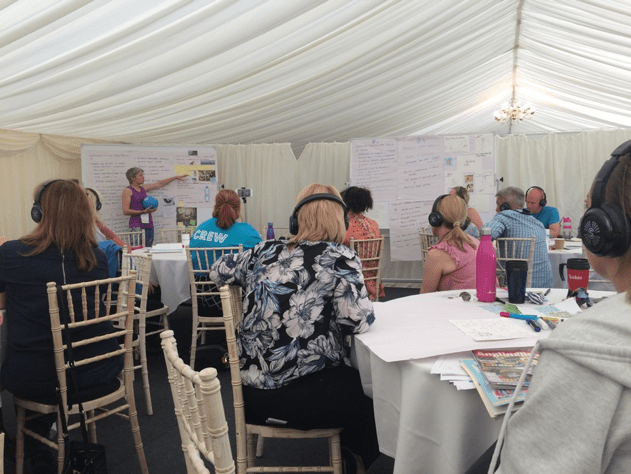
Introduction to the event
Here’s how Northumbrian Water were promoting the event on their Innovation Festival 2019 website:
Water Well Being with Newcastle Upon Tyne Hospitals
“This daily dash will explore ways to encourage people to drink more tap water so that they stay hydrated. There are so many benefits to being hydrated and so many problems can occur when hydration levels are low, especially amongst vulnerable groups such as the elderly and unwell. We want to identify innovative ways to promote hydration as a key factor in keeping people healthy.”
Get complete clarity on the purpose of the event
It’s really important to clearly identify and articulate the specific purpose for any event that you are running. I had calls with Lisa, Associate Director of Nursing and her team from Newcastle Upon Tyne Hospitals NHS Foundation Trust, as well as with Angela, Claire and Denise at Northumbrian Water to better understand what they wanted to achieve.
They said that the purpose of the innovation sprint is to develop themes, messages, concepts and channel ideas for a regional communication campaign for the north east of England.
The campaign is to motivate more vulnerable members of the community to stay hydrated, and especially to prevent infections and ultimately sepsis by drinking more tap water. Sepsis is a serious complication of an infection. Without quick treatment, sepsis can lead to multiple organ failure and death.
From the brief, I created a ‘big question’, also known as a point of view statement (PoV) in design thinking, or problem statement in creative problem solving, as follows:
How to create a positive, creative campaign for the north east that motivates everyone in our community to stay hydrated, including
…how to eliminate all cases of serious illness due to dehydration in the north east.
…partnership opportunities.
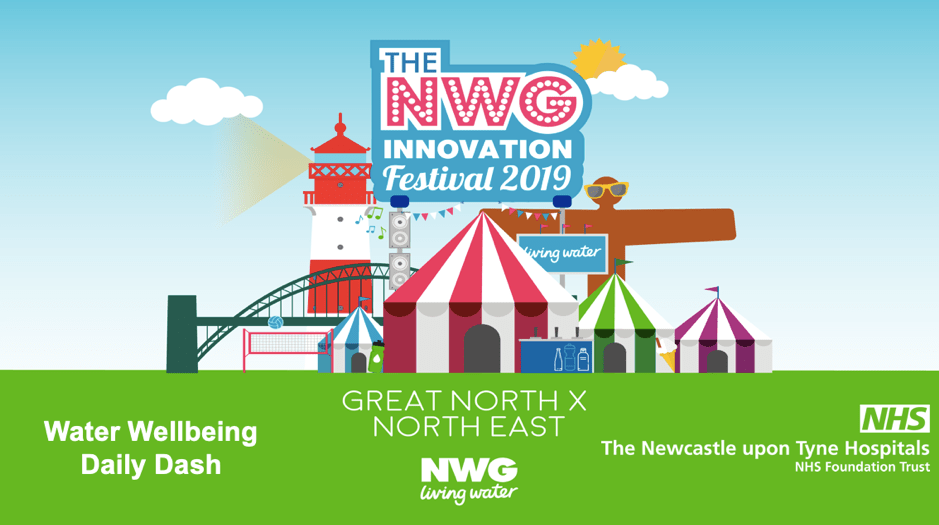
Make sure that participants have enough information to work with
It’s important to understand the context of the issue and key information before the innovation process can begin. For this reason, we invited “lightning talks” from expert speakers to set the scene and give delegates the background they need to frame the challenge for the day.
Lightning Talk technique – when to use it and why
Lightning talks are a series (usually at least 4 – 5) of short talks or presentations by
different speakers. Each talk lasts for about 5-10 minutes maximum.
Using lightning talks in this way has the benefit of being able to share focused information on a varied range of topics in a time efficient way, and without subjecting delegates to information overload.
Each presentation consists of a minimum number of slides, if any at all, with a total of 1 or 2 key messages per speaker. Delegates have the opportunity to ask questions at the end.
Our fabulous expert speakers for the day were:
- Paula, Specialist Nurse Nutrition and Hydration and Jen, Adult Dietetic Manager– The importance of effective hydration
- Jacqueline, Specialist Nurse Complex airway – The effects of poor hydration in tracheostomy patients
- Jackie, Nurse Consultant Continence – Let’s talk about urinary tract infections & water well being
- Catherine, Infection Prevention and Control Nurse – UTI prevention and promoting hydration in care homes
Get the right people in the room
We were expecting c. 30 attendees from the NHS, Northumbrian Water and others from different organisations and professions, so a very diverse group. Due to the registration process, which was promoted and opened to the public, we weren’t going to know for sure who and how many people would be there beforehand.
As is the case for many community co-creation events, this meant that the facilitation plan needed to be designed with flexibility and accessibility for everyone in mind.
Click to get your free DIY Away Day Toolkit now!
Understand the time available
The timings we needed to work to were:
9.30-12.30 In session
12.30-13.30 Lunch break
13.30-16.30 In session
The final facilitation plan that I created and used is here:
How the event worked on the day
How the event worked on the day
We started off with my speed dating intros. I briefed delegates that they were to meet as many new people as possible within the time allowed, and write down their names, organisation – also the name of the movie star they would like to play them in a film of their life story, and why.
This got everybody up, talking, smiling and connecting really quickly, which was very important because most people didn’t know each other, and time on the day was understandably limited. We needed to get people to feel productive and comfortable collaborating as quickly as we could, and this activity worked a treat.
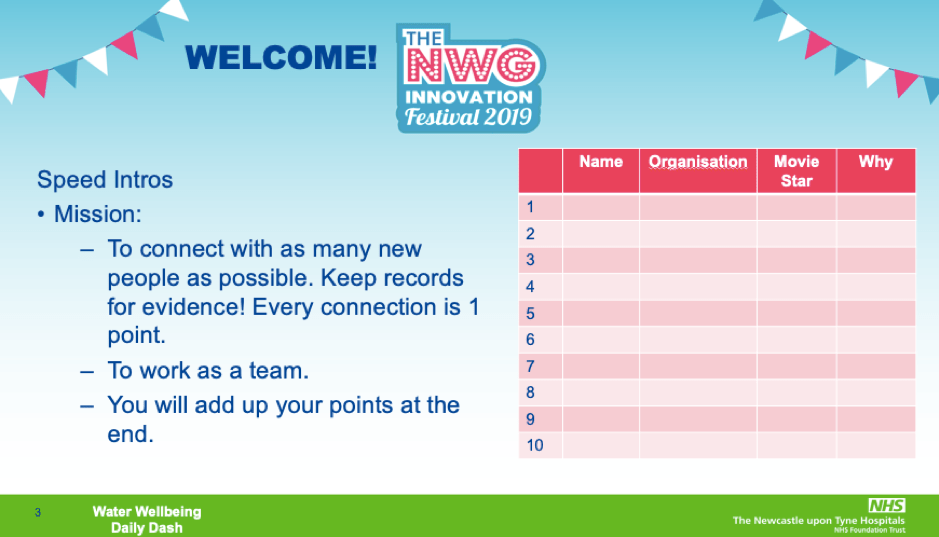
We then asked delegates to form a circle around the venue in order of the time they went to bed the night before. Again, this was fun, got people moving and talking, and helped us to mix people into smaller groups – “idea squads” – to get some great diversity of thinking and conversations going.
Lightning Talks
The lightning talks worked really well. Each of the experts shared really helpful, insightful and clear information, and they all stuck to time and kept the momentum of the event going.
Wouldn’t it be fantastic if…
We wanted our delegates to focus on the aspect(s) of our big question that resonated the most with them. Our delegates worked in their idea squads to create their own specific big question using the Wouldn’t it be fantastic if… (wifi for short) technique.
Wifi technique
We asked each idea squad to complete the following statement as many times as possible for our Big Question:
Wouldn’t it be fantastic if…
Once they had done that, we asked the delegates to:
- Select the statements that will make the biggest and most positive difference.
- Put together connected ones that they wanted to combine into a new statement.
- Write their final statement on a flipchart, ready to share.
The WIFI technique is really simple and surprisingly effective. We began with it because it opens up thinking and frames challenges as positive and motivational possibilities. What is nice about the ’Wouldn’t it be fantastic if…’ activity is that it seeks the identification of current and potential problems within a positive framework by taking the mind to a better place, i.e. one that is solution-focused.
Click to get your free DIY Away Day Toolkit now!
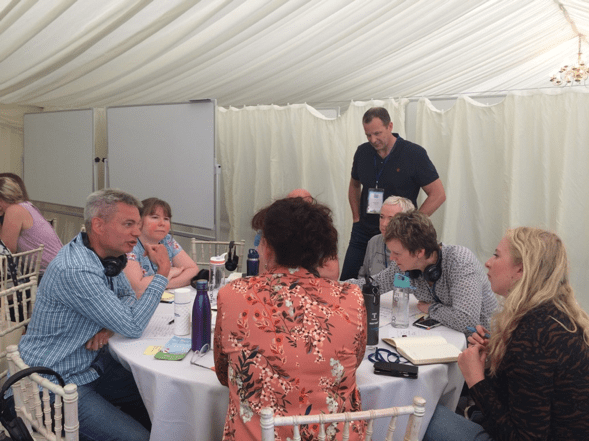
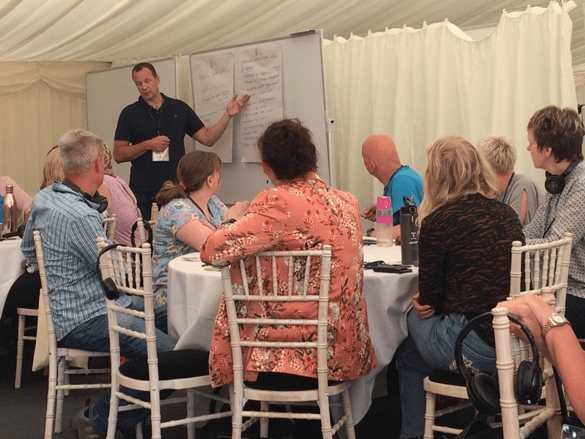
Bugs and Loves
All the way through the event, we took time to stop and feedback after each activity and make sure that the outputs from the previous activity flowed into the next.
When tackling a challenge, it’s great to include an activity that focuses on what is getting in the way of achieving the target outcome, and also what can help.
In our innovation dash, we used my bugs and loves technique to do this.
Bug listing technique
Bug Listing is a technique developed by Adams in his book Conceptual Blockbusting: A Guide to Better Ideas, 1987. I have evolved it and given it my own stamp, especially by adding in ‘loves’ as well as ‘bugs’.
Many great entrepreneurial ideas come about because of something that ‘bugs’ the entrepreneur, that they then take action to do something about. A bug list is a list of things that ‘bug’ – i.e. frustrate, worry, or irritate – your customers or users. You can focus specifically on the products and services that your business offers or go wider and include their bugs in the context of your industry and competitors.
We shared a great and really relevant real-life example of ‘bugs and loves’ in action. Engineering graduate Lewis Hornby was worried about his grandmother, who suffers from dementia, not drinking enough water. A ‘bug’ for her is not liking water. Lewis created jelly sweets which are over 90% water to keep her hydrated. The project was also part of his university Masters-level studies at the Royal College of Art. Lewis invented the bite-sized liquid balls -jelly sweets- to get the fluids into his grandmother’s system, and she ‘loves’ them because she enjoys sweets. Click for an article about it from the online Metro newspaper.
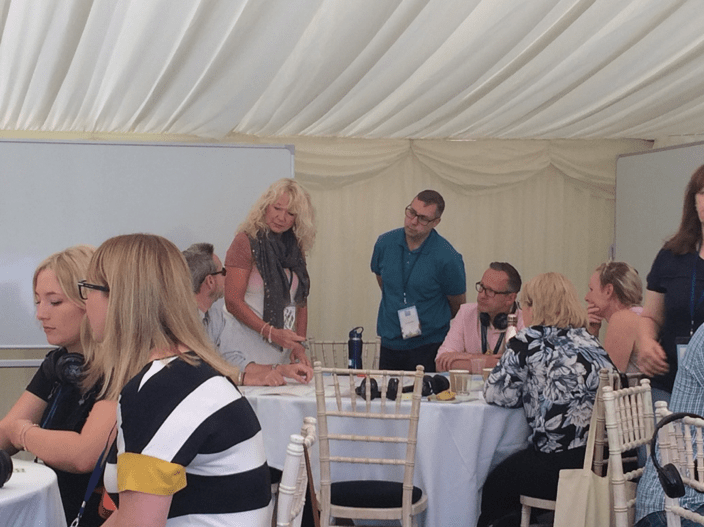
We then briefed our delegates as follows:
Each idea squad to work on a different theme:
- School, home, work and out & about, care home, hospital
- List:
- All the bugs (things that get in the way of people drinking water)
- All the loves (things that help people to drink enough water)
- Add in:
- When is it most likely that people will not drink enough?
- Now write down as many ideas as possible to:
- Overcome the bugs (things that get in the way of people drinking water)
- Make the most of the loves (things that help people to drink enough water)
- Make it more likely for people to drink enough water at times when they don’t drink enough
Click to get your free DIY Away Day Toolkit now!
Rapid Idea Generator
Our delegates were by now super-warmed up and their creativity was flowing! We built on this by using my rapid idea generator technique, which is inspired by the brainwriting technique.
Brain writing
A small group of people sits around a table, each with a sheet of paper and pen.
Each person writes down three ideas in three minutes on the paper in front of them.
Participants then pass the papers to the person on their right, who spends 3 minutes developing or adding to the ideas on the sheet they have in front of them.
These steps are repeated until the papers are returned their original authors, who sort and share the outcomes with their colleagues.
I had prepared enough individual A4 sheets for each of the delegates. Each A4 sheet contained either a random motivational quote, a random magazine advertisement, a relevant hydration fact or statistic, and a water-related image.
Delegates then worked individually on their sheet for 3 minutes, capturing all the ideas stimulated by the item on their A4 sheet. They then passed their sheets round clockwise to the next person, and had 4 minutes (to include reading time) to add in to what the previous person had written about their prompt. We did this for another 2 rounds (so 4 rounds in total).

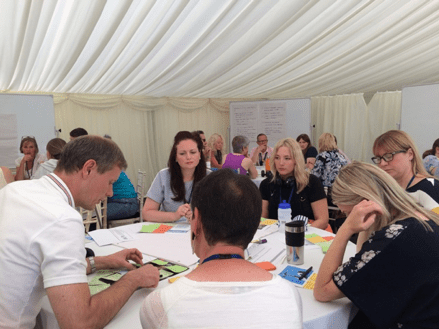
This worked absolutely brilliantly and generated some super ideas.

Sharing inspiration
We shared insight and real-life examples from Thaler’s nudge theory, and also different types of highly effective partnership and media communication campaign solutions. Examples are Lidl’s Avoracle campaign, which went viral on social media, and NASA’s Earth Day Global Selfie campaign. Sharing examples such as these can re-energise idea generation and provide helpful stimulation, especially when the examples are out-of-sector.
Idea development
Delegates then worked in their idea squads to select their most useful ideas and develop them into a solution to present back at the end of the day.
We provided old magazines, newspapers and collage resources for cutting up and sticking down so that participants could get really visual and bring their ideas to life.
Presentations
The solution presentations were absolutely awesome. Packed with great ideas, and when they have all been combined, we are confident that they will make a significant difference towards solving the big question that we started off with at the beginning of the day. This article is hot off the press and written immediately after the event. As soon as I can, I will share the solutions with you and how we followed up with action and continued momentum.
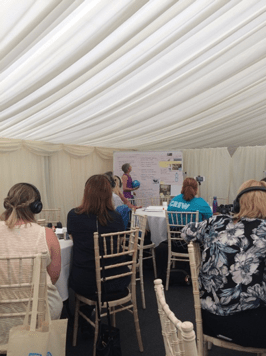
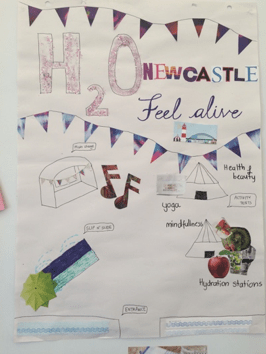
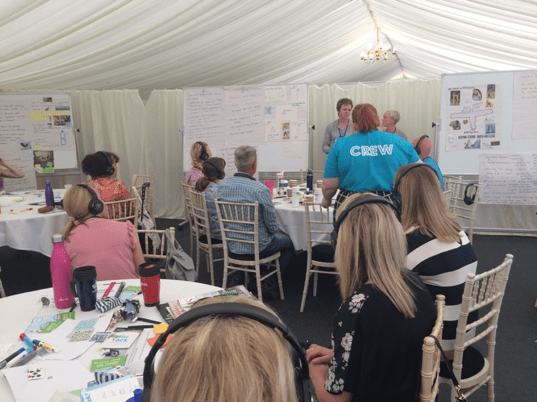
Next steps
I hope that this has given you some ideas for your own events in the future. If you’d like any tips, ideas or advice, do feel free to contact me direct on +44 7879 631270 or jo@bigbangpartnership.co.uk.
We also provide exceptional Creative Facilitation courses and programmes. If you’d like more information to help you run your own events, download my free DIY Away Day toolkit. It’s a great resource and contains an agenda, instructions for all the creative techniques I suggest plus my top tips for successful facilitation.
